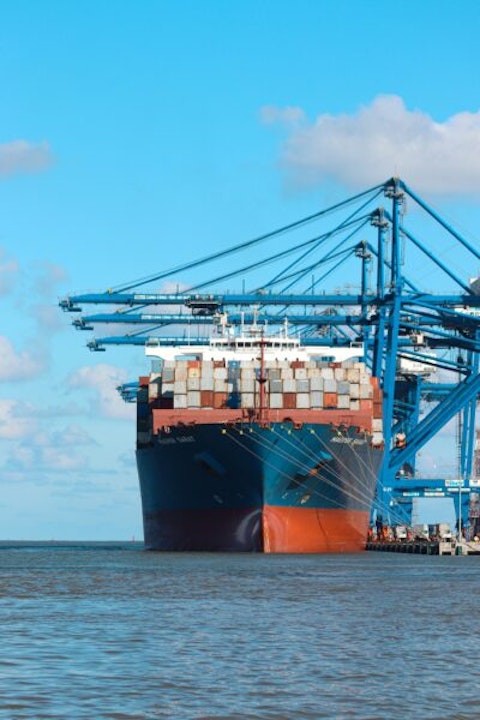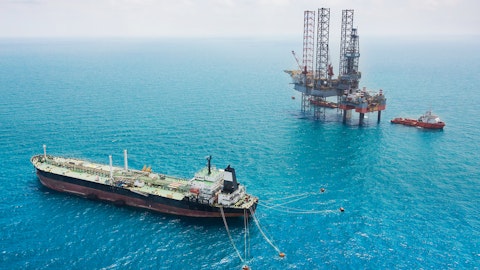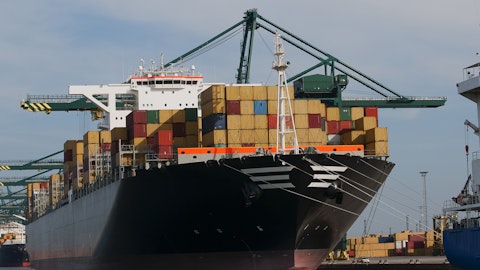SFL Corporation Ltd. (NYSE:SFL) Q3 2022 Earnings Call Transcript November 14, 2022
SFL Corporation Ltd. beats earnings expectations. Reported EPS is $0.39, expectations were $0.28.
Ole Hjertaker: Hi, everyone, and welcome to SFL’s third quarter conference call. We do apologize for the problems with our service provider who has delayed the call now for more than 20 minutes. But I hope you have been patient and are able to listen in to us still. I will start the call by briefly going through the highlights of the quarter. Following that, our CFO, Aksel Olesen, will take us through the financials, and the call will be concluded by opening up for questions. Our Chief Operating Officer, Trym Sjølie will also be present for the Q&A session. Before we begin our presentation, I would like to note that this conference call will contain forward-looking statements within the meaning of the U.S. Private Securities Litigation Reform Act of 1995.
Words such as expects, anticipates, intends, estimates or similar expressions are intended to identify these forward-looking statements. Forward-looking statements are not guarantees of future performance. These statements are based on our current plans and expectations and are inherently subject to risks and uncertainties that could cause future activities and results of operations to be materially different from those set forth in the forward-looking statements. Important factors that could cause actual results to differ includes, but are not limited to, conditions in the shipping, offshore and credit markets. You should therefore not place undue reliance on these forward-looking statements. Please refer to our filings with the Securities and Exchange Commission for a more detailed discussion on our risks and uncertainties, which may have a direct bearing on our operating results and our financial condition.
The total charter revenues were $178 million in the quarter, which was up 8% compared to the second quarter. The maturity of revenues was from vessels on long-term charters and around 18% for vessels deployed on short-term charters and in the spot market. The EBITDA equivalent cash flow in the quarter was approximately $126 million. And over the last 12 months, the EBITDA equivalent has been $489 million. The net income came in at around $50 million in the quarter or $0.39 per share. This includes contributions from profit share arrangements and also positive mark-to-market on interest rate swaps and equity and bond investments. The announced dividend of $0.23 per share is in line with the dividend declared for the second quarter and represents a dividend yield of around 8.8% based on closing price on Friday.

Photo by Nathan Cima on Unsplash
This is our 75th quarterly dividend. And over the years, we have paid more than $2.5 billion in total or more than $28 per share, and we have a robust charter backlog supporting continued dividend capacity going forward. And our fixed rate backlog has increased significantly over the last year and now stands at approximately $3.8 billion from owned and managed vessels after recent acquisitions and charters, providing continued cash flow visibility going forward. And importantly, the backlog figure excludes revenues from the vessels traded in the short-term market and also excludes future profit share optionality, which we have seen can contribute significantly to our net income. We have recently announced the acquisition of 4 modern eco-design Suezmax tankers in combination with long-term charters to Koch Industries.
Two vessels were delivered in the third quarter and 2 delivered after quarter end, and full cash flow effect will therefore be from the first quarter 2023. The transaction added $250 million to a fixed rate charter backlog and demonstrates our standing in the market as a high-quality provider of transportation services including tactical management, vessel operations and vetting for industry-leading customers. Based on market sources, the charter free value of these vessels are already up 16% compared to our purchase price. This does not mean that anything for the near-term cash flows, but it’s important for the overall risk profile for us. In early September, we announced the acquisition of 2 new build feeder container vessels. This was an opportunity that came up on short notice and a result of our strong business relationship with Maersk Line, where we have done multiple repeat business transactions over the last years.
We were able to step in and organize the takeout of the first vessel from the shipyard in China in a matter of only a few weeks, and the structure of the charter enables us to derisk the deal significantly over the charter period with a relatively high charter rate. To balance this, we can immerse the benefit of purchase options below mid-cycle levels, but still with a profit share to SFL. The first vessel was delivered and entered service for Maersk in the September and the second vessel is due in just a few days now. They’ve also recently agreed to acquire a 2010-built midsized car carrier with long-term charter to a large Korea-based logistics company. The contract runs until mid-2028 and adds $65 million in fixed rate charter revenues in addition to potential significant benefits from the vessels installed scrubber where most of the economics goes to SFL.
The economic return on the vessel is strong even without leverage, but we plan to source financing for the vessel in due course, which will boost the returns from this deal. And while it is a single vessel, it will be managed tactically and operationally together with our 2 existing car carriers and/or 4 vessels under construction, which will ensure operational efficiency. We also own 2 harsh environment drilling rigs, Linus and Hercules, which were chartered to subsidiaries of Seadrill for a number of years. In connection with Seadrill’s recent Chapter 11 restructuring, we agreed to take the rigs back and the long-term drilling contract for Linus with ConocoPhillips was assigned from Seadrill to SFL at the end of the third quarter. Odfjell Technology is managing the rig for us technically and operationally, and the transition, including government approvals, was seamless and without any commercial off-hire.
The charter rate is adjusted semiannually. And currently, the charter rate is approximately $199,000 per day, up from $193,000 per day from May through October. Operating expenses is currently approximately $125,000 per day. The harsh environment semi-submersible rig Hercules is still on charter to Seadrill, while it is finalizing a drilling contract with Equinor before we deliver to SFL in Norway in December. This rig will be managed technically and operationally by Odfjell Drilling going forward. The rig is one of only a handful of rigs fully equipped to drill in the harshest Arctic environment, and market analysts are positive to market prospects based on recent tender activity and a tight supply-demand balance. We have seen that the international market for deepwater drilling rigs without these harsh environment features have risen quickly.
The harsh market has been lagging this, but we believe prospects for 2024 and 2025, in particular, is very promising. Before a new contract, the rig will have to complete a scheduled comprehensive special periodic survey, and we are considering some upgrades to the rig to make it more attractive for longer-term contracts. Currently, we estimate SPS cost to approximately $50 million plus potential contract-specific upgrades. The rig will be available for new contracts from middle of the second quarter, and there is good progress on new charter opportunities. We therefore hope to be able to announce a drilling contract soon. Over the years, we have changed both fleet composition and structure, and we now have 78 maritime assets in our portfolio, and our backlog from owned and managed shipping assets stands at $3.8 billion up from $3.7 billion in the previous quarter.
Over the years, we have gone from a single asset class charter to 1 single customer to a diversified fleet and multiple counterparties, and the fleet composition has varied from 100% tankers to nearly 60% offshore 10 years ago to container vessels now being the largest segment with 53% of the backlog. Most of the vessels are on long-term charters and more than 90% of charter revenues from our shipping assets came from time charter contracts and only 8% on bareboat or dry lease. In addition to fixed rate charter revenues, we have had significant contributions to cash flow from profit share over time, both relating to charter rates and fuel savings. Last 12 months, the aggregate profit share has been $28.5 million with $11.3 million in the third quarter alone.
And we do not have a set mix in the portfolio. Focus is on evaluating deal opportunities across the segments and try to do the right transactions from a risk-reward perspective. Over time, we believe this will balance itself out but we try to be careful and conservative in our investments with a focus on technology and transition over time to more fuel-efficient vessels. The strength of our counterparties and diversification is key when we assess our portfolio and quality of our contracted backlog, and the list speaks for itself with market-leading operators like Maersk, Hapag Lloyd, ConocoPhillips, P 66, Koch Industry and Volkswagen to name a few. Relatively few of our customers are intermediaries where we have less visibility on the use of the assets and quality of operations.
Strategically, this also gives us access to more deal flow opportunities such as the repeat business with Maersk, MSC, Evergreen and Trafigura, for example. Our strategy has therefore been to maintain a strong technical and commercial operating platform in cooperation with our sister companies in the Seatankers Group. This gives us the ability to offer a wider range of services to our customers from structured financing to full-service time charters. And with full control of our vessel maintenance and performance, including energy efficiency and emission-minimizing efforts, we can impact improvements to our vessels through the life of the assets and not only be passively owning vessels employed on bareboat where the customers may not always have an incentive to make such improvements.
In addition, we can retain more of the residual value in the assets when we charter out the time on an on-charter basis. And in the current environment with rising raw material costs and inflation driving replacement cost for vessels, this value is for the benefit of SFL and our stakeholders. For bareboat charter deals, the value is usually retained by the charterer through fixed price purchase options. And with that, I will give the word over to our CFO, Aksel Olesen, who will take us through the financial highlights for the quarter.
See also 11 Biggest Music Festivals in the World and 12 Best Stocks To Invest In.
Aksel Olesen: Thank you, Mr. Hjertaker. On this slide, we have shown a pro forma illustration of cash flows for the third quarter. Please note that this is only a guideline to assess the company’s performance and is not in accordance with U.S. GAAP and also net of extraordinary and noncash items. The company generated gross charter hire of approximately $178 million in the third quarter, including approximately $11 million of profit share, with approximately 82% of revenue coming from our fixed charter rate backlog, which currently stands at $3.8 billion, providing us with strong visibility on our cash flow going forward. In the third quarter, the liner fleet generated gross charter hire of approximately $98 million, including approximately $10 million in profit share contribution related to fuel savings on some of our large container vessels.
At the end of the third quarter, the SFL fleet backlog was approximately $2 billion with an average remaining charter term of approximately 4.7 years or 7.4 years, if weighted by charter hire. The charter backlog includes approximately $0.5 billion of backlog from 7 car carriers. In the third quarter, SFL has a fleet of 18 crude oil products and chemical tankers, with the majority employed on long-term charters. Our tanker fleet generated approximately $42 million in gross charter hire during the quarter compared to $35 million in the previous quarter as well as 2 Suezmax tankers and 2 small chemical tankers trading in the spot and short-term markets. The charter hire from these vessels was approximately $11.5 million in the third quarter compared to approximately $6.6 million in the second quarter.
The company has 15 dry bulk carriers, of which 9 were employed on long-term charters during the quarter. SFL generated approximately $27 million in gross charter hire from the dry bulk fleet in the third quarter, including approximately $1.2 million of profit share. Fixed vessels were employed in the spot and short-term market and contributed approximately $10 million in net charter hire during the third quarter compared to approximately $30 million in the previous quarter. SFL owns 2 drilling rigs, which have been charted out or subsidiaries of Seadrill on variable terms. In the third quarter, the company received charter hire of approximately $10 million from the rigs. The largest was redelivered to SFL at the end of the third quarter. We will, from the fourth quarter, receive full recontract revenue from ConocoPhillips and Teri OpEx, similar to a ship on a time charter.
And we also expect close to full quarterly revenue from the Hercules in the fourth quarter as the rig is expected to be redelivered at the very end of the year. This summarizes to an adjusted EBITDA of approximately $126 million for the third quarter compared to $124 million in the second quarter. We then move on to the profit and loss statement as reported under U.S. GAAP. As we have described in previous earnings calls, our accounting statements are different from those of a traditional shipping company. As our business strategy focuses on long-term charter contracts, a large part of our activities are classified as capital leasing. Therefore, a significant portion of our charter revenues are excluded from U.S. GAAP operating revenues. This includes repayment of investments in sales type, direct financing leases and leaseback assets and revenues from entities classified as investment in associates for accounting purposes.
For the third quarter, we report total operating revenues according to U.S. GAAP of approximately $167 million, which is less than approximately $178 million of charter hire actually received for the reasons just mentioned. The company recorded profit share income of approximately $1.2 million of size dry bulk vessels, in addition to approximately $10 million from fuel saving arrangements on some of our large containers. Furthermore, the company recorded a $5.5 million gain related to positive mark-to-market effects related to interest rate swaps. And at quarter end, approximately 70% of our financing was fixed rate or swap to fixed by financial hedging instruments. With the recent rate in interest rates, we now see the benefits of a conservative approach to financing.
And similar to our charting strategy, we aim to have significant diversification in our funding base both in terms of structure and geography as this has given us more flexibility over time. Based on our assumptions, we estimate that 1 percentage increase in interest rates from our current levels equals approximately $0.02 per share in lower distributable cash flow per quarter and vice versa. And in evaluating new investment opportunities, we take a conservative approach in assuming the interest rate cost during the life of the project, I mean generally seek to fix the interest rate back to back with the fixed charter duration or include an interest rate adjustment in the charter rates. In addition, the company recorded an $8.6 million gain related to positive mark-to-market effects related to equity and debt investments, an increase of $500,000 in credit loss provision.
So overall, and according to U.S. GAAP, the company reported a net profit of approximately $50 million or $0.39 per share. Moving on to the balance sheet. At quarter end, SFL approximately $129 million of cash and cash equivalents. Furthermore, the company has marketable securities, approximately $9.3 million based on market prices at the end of the quarter. In addition, the company had 5 debt-free vessels at quarter end with a combined charter value of approximately $114 million based on average broker appraisals. During the third quarter, SLF secured refinancing facilities for its 8 capesize vessels and 2 Kamsarmax vessels for $115 million and $23 million, respectively. Also during the third quarter, the company entered into agreements for long-term financing of the 2 14,000 TEU container vessels, Thalassa Patris and Thalassa Elpida, as form of Japanese operating leases.
The combined amount is $240 million and the first vessel closed in October, whereas the second one is scheduled for December. The transaction frees up approximately $120 million compared to previously secured financing on these 2 vessels. Furthermore, SFL is in advanced discussions to enter into a long-term financing facility of approximately $144 million to part finance 4 recently-acquired Suezmax tankers. This facility is expected to close later in the fourth quarter. The approximately $225 million of remaining CapEx on our 4 car carriers under construction is expected to be financed by senior debt facilities similar to as well as other assets with long-term charters. Based on the Q3 numbers, the company had a book equity ratio of approximately 29%.
Then to conclude. The Board has declared a cash dividend of $0.23 per share for the quarter. This represents a dividend yield of approximately 8.8% based on the closing share price last Friday. Following our recent investments and charter arrangements this year, we have added more than $1.4 billion for fixed rate backlog which now stands at $3.8 billion, providing us a strong visibility on future cash flow that service a continued dividend distribution capacity. With a strong balance sheet and significant investment capacity, SFL is very well positioned to execute on new accretive investments to continue to create shareholder value. Thank you.
Ole Hjertaker: And then I would like to thank everyone here who has helped us prepare the material for the third quarter. Unfortunately, due to the technical issues with the service provider, it’s not possible to conduct a question-and-answer session. So I will ask anyone who has questions who want anything clarified to contact us either through our webpage on the contact page of our webpage, www.sflcorp.com. And also, there are contact details direct to several persons in the press release that you can reach out to, to get these answered. So with that, I would like to wrap up the conference call, and I promise you this technical issues we expect will not be there next quarter. Thank you.
End of Q&A:




